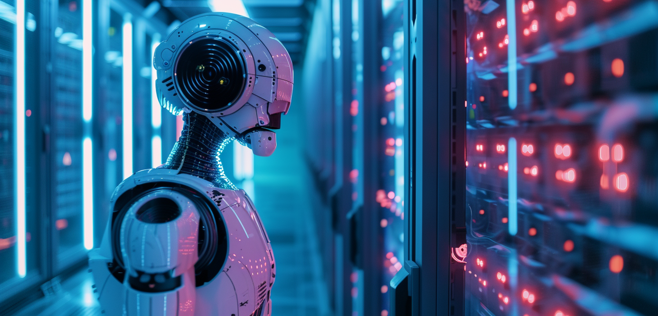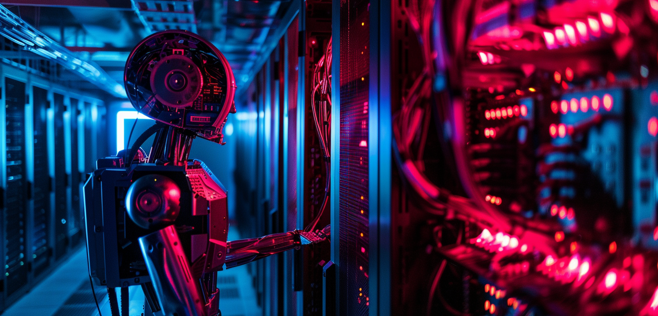 14 Nov 2024
14 Nov 2024The Impact of AI on Crypto Mining: Optimization and Efficiency

Crypto mining plays a crucial role in the blockchain ecosystem, as it verifies transactions and secures the network by adding new blocks to the chain. In this process, miners use powerful hardware to solve complex mathematical problems, earning rewards in the form of cryptocurrency. However, crypto mining comes with significant challenges, including high energy consumption, rising hardware costs, and the growing difficulty of mining as more participants join the network.
Artificial Intelligence (AI) has been a transformative force across numerous industries, offering innovative ways to enhance efficiency and streamline processes. In the context of crypto mining, AI has begun to play a vital role in addressing some of the industry’s biggest challenges. By leveraging AI-driven insights and automation, mining operations are becoming more optimized, cost-effective, and sustainable.

The Basics of Crypto Mining and Its Challenges
Crypto mining is the process by which new transactions are verified and added to a blockchain, ensuring the security and integrity of the network. Miners use computational power to solve complex mathematical puzzles, which allows them to validate transactions and add a new block to the chain. As a reward for their efforts, miners receive cryptocurrency, making mining a profitable, though highly competitive, activity.
Key Challenges in Crypto Mining
Despite its importance, crypto mining faces several significant challenges:
- Energy Consumption
Mining requires vast amounts of electricity to power the hardware needed for solving complex algorithms. As mining difficulty increases, so does the energy demand, leading to high operational costs and environmental concerns.
- Hardware Costs
Successful mining relies on powerful hardware, such as GPUs (Graphics Processing Units) or specialized ASIC (Application-Specific Integrated Circuit) miners, which are both costly to purchase and maintain. Regular upgrades are necessary to keep up with the competition, further increasing expenses.
- Increasing Difficulty Levels
As more miners join the network, the difficulty of mining adjusts to maintain a consistent block time. This rising difficulty requires even more computational power, making it harder for individual miners to compete and earn rewards without significant investments.
The Need for Solutions to Improve Efficiency and Reduce Costs
With the growing challenges in energy use, hardware expenses, and mining difficulty, the need for more efficient solutions has become paramount. Optimizing mining operations can lead to reduced costs, higher profitability, and a smaller environmental footprint. This is where AI technology comes into play, offering powerful tools to help miners streamline operations, manage resources effectively, and overcome the barriers associated with crypto mining.

How AI is Transforming Crypto Mining
Artificial Intelligence is bringing a new level of sophistication to crypto mining by automating processes, improving operational efficiency, and minimizing costly disruptions. Here’s a closer look at how AI-driven tools and techniques are reshaping the crypto mining landscape.
Machine Learning for Predictive Maintenance
One of the significant applications of AI in crypto mining is predictive maintenance. Machine learning algorithms analyze historical data from mining equipment to predict when hardware components are likely to fail or require maintenance. By detecting early warning signs of potential issues, AI can help miners address problems before they lead to costly downtime.
- Reduced Downtime
Predictive maintenance schedules reduce unexpected breakdowns, keeping mining operations running smoothly.
- Cost Savings
By fixing equipment only when necessary, miners can avoid the expense of unnecessary repairs and replacements, optimizing their budgets.
Data Analysis for Efficiency
AI algorithms can analyze vast amounts of data generated by mining operations, including metrics like energy consumption, hardware performance, and mining output. This data-driven approach helps identify inefficiencies and opportunities to optimize resource usage, particularly in energy management.
- Improving Energy Efficiency
By analyzing power usage patterns, AI can suggest adjustments to reduce energy waste, resulting in significant cost savings.
- Resource Allocation
AI can identify optimal times to scale up or down mining operations, allowing miners to make informed decisions based on real-time data, thus ensuring that resources are used more effectively.
Automated Decision-Making
AI enables automated decision-making, allowing mining operations to make real-time adjustments to critical parameters, such as hash rate, energy usage, and cooling levels. By automating these decisions, AI can maximize output while minimizing costs, helping miners maintain optimal efficiency even during fluctuations in market demand and mining difficulty.
- Real-Time Adjustments
AI can automatically fine-tune mining parameters to respond to changes in network difficulty or energy availability, ensuring maximum productivity.
- Enhanced Profitability
With AI-driven optimization, miners can maintain high levels of performance without constant manual oversight, allowing them to stay competitive in a rapidly evolving market.
Through predictive maintenance, data analysis, and automated decision-making, AI is enabling crypto miners to operate more efficiently and cost-effectively. By transforming how resources are managed and optimizing operational processes, AI is making crypto mining more sustainable and accessible, setting the stage for a new era of innovation in the industry.

Optimizing Energy Consumption with AI
Energy consumption is one of the most pressing challenges in crypto mining, with high power demands driving up operational costs and raising environmental concerns. AI offers powerful tools to help miners manage and reduce energy usage, making mining more sustainable and cost-effective. Through advanced algorithms and real-time monitoring, AI optimizes how energy is consumed in mining operations, contributing to both profitability and environmental responsibility.
The Role of AI in Reducing Energy Demands
AI helps reduce energy demands by analyzing power usage patterns and implementing strategies to manage consumption. By continuously monitoring energy needs and adjusting usage based on real-time conditions, AI ensures that mining operations consume only as much energy as is necessary for optimal performance. This targeted approach reduces waste and lowers overall energy costs.
Techniques for Energy Efficiency
-
Smart Energy Allocation: AI-driven systems can allocate energy more efficiently by directing power only to machines actively mining or those with the best performance, reducing the energy wasted on underperforming equipment.
-
Load Balancing: AI helps manage power distribution across mining rigs, balancing the load to prevent overuse of any single component and distributing energy more evenly. This process reduces strain on hardware and leads to more stable, energy-efficient operations.
-
Adaptive Cooling Systems: Cooling is critical for mining equipment, but it can consume a significant amount of power. AI-driven cooling systems adjust cooling levels in response to real-time temperature and usage data, reducing unnecessary cooling and optimizing power use. This approach not only saves energy but also extends the lifespan of mining hardware.
Case Studies: AI-Driven Energy Efficiency in Crypto Mining
- Northern Bitcoin AG
This German-based mining company has adopted AI-based cooling systems that adjust fan speeds and cooling mechanisms based on real-time temperature and load conditions. By using AI to automate cooling, the company has significantly reduced its energy expenses, contributing to both cost savings and environmental sustainability.
- HIVE Blockchain Technologies
HIVE, a blockchain infrastructure company, leverages AI for energy allocation and load balancing across its mining facilities in North America and Europe. Through AI-driven power management, HIVE has achieved greater energy efficiency, which helps reduce operational costs and improve profitability while maintaining high mining output.
- Genesis Mining
Genesis Mining, a major player in the crypto mining industry, uses AI-powered analytics to optimize energy consumption across its large-scale mining operations. By integrating smart energy allocation and adaptive cooling, Genesis has been able to reduce its energy demands and maintain performance during times of peak usage.
Through these energy optimization techniques, AI is helping crypto mining companies achieve a more efficient and sustainable operation. By minimizing energy consumption and intelligently managing resources, AI enables miners to enhance profitability while contributing to the environmental sustainability of crypto mining.

Enhancing Hardware Performance through AI
In crypto mining, hardware performance directly impacts profitability. As mining difficulty rises, miners rely on advanced hardware configurations like GPUs and ASICs to maximize their output. AI is playing a transformative role in optimizing the performance of this hardware, helping miners achieve higher efficiency, extend the lifespan of equipment, and ultimately boost profitability.
How AI is Used to Monitor and Optimize Hardware Performance
AI can monitor key performance metrics, such as temperature, power consumption, and processing speeds, in real-time. By analyzing this data, AI systems can detect inefficiencies or potential performance bottlenecks, enabling miners to make proactive adjustments. This level of monitoring also provides early warnings of potential hardware failures, allowing for maintenance before problems escalate, thus minimizing downtime.
- Real-Time Monitoring
AI continuously monitors hardware, adjusting settings based on current performance and environmental factors. This adaptive approach keeps equipment running optimally and can reduce wear on critical components.
- Predictive Analytics
AI uses historical data to forecast hardware performance issues, allowing for timely intervention to prevent performance dips or breakdowns.
AI-Driven Overclocking and Cooling Solutions
-
Overclocking with AI: Overclocking is a technique that pushes hardware beyond its default settings to achieve higher processing speeds. AI can safely automate overclocking by testing and applying optimal performance settings without risking hardware damage. By incrementally adjusting processing speeds based on current temperatures and workloads, AI ensures a balance between performance gains and hardware safety.
-
Adaptive Cooling Solutions: Effective cooling is crucial to prevent hardware from overheating and to maintain stable performance. AI-driven cooling systems adjust cooling levels dynamically, increasing airflow only when needed and reducing it during periods of low load. This not only conserves energy but also protects hardware from thermal stress, which can degrade components over time.
Benefits of AI in Extending Hardware Lifespan and Maximizing Output
- Increased Longevity
By optimizing performance and managing temperature, AI helps extend the lifespan of GPUs and ASIC miners. When hardware runs at balanced, optimal levels, there is less strain on components, reducing the likelihood of premature wear and the need for frequent replacements.
- Consistent Performance
AI-driven monitoring and adjustments keep hardware running smoothly, ensuring a stable hash rate and output. By reducing performance fluctuations, AI helps miners maintain steady production and profitability.
- Reduced Maintenance Costs
With predictive maintenance and adaptive cooling, miners can avoid costly repairs and replacements, cutting down on operational expenses. This makes AI an invaluable asset for miners looking to maximize hardware investment returns.
Through AI-driven monitoring, overclocking, and cooling solutions, crypto miners can get the most out of their equipment while minimizing risk and operational costs. By enhancing hardware performance and extending lifespan, AI not only boosts profitability but also supports a more sustainable approach to crypto mining, where resources are used more efficiently.

The Role of AI in Security and Fraud Detection
Security is a critical concern in crypto mining, as the valuable assets and intensive resources involved make mining operations a prime target for cyber threats. Malware attacks, unauthorized access, and fraud attempts are some of the common risks that can disrupt mining operations and lead to substantial financial losses. AI-driven security solutions are becoming essential in safeguarding mining infrastructure, providing real-time threat detection, and fortifying operations against potential cyber attacks.
Overview of Security Challenges in Mining
Crypto mining operations face several security challenges:
- Malware Attacks
Malicious software, such as cryptojacking malware, can hijack mining resources and secretly mine cryptocurrency on behalf of attackers. This not only diverts resources but can also damage hardware and increase energy consumption.
- Unauthorized Access
With mining rigs often operating remotely or in data centers, unauthorized access to mining systems poses a significant risk. Attackers may gain access to critical controls, altering settings or even shutting down mining operations.
- Fraud and Data Theft
Mining operations may store valuable data, including cryptocurrency keys and transaction records, which could be compromised through phishing attacks, social engineering, or network breaches.
How AI-Based Security Systems Identify Threats
AI-based security systems use advanced algorithms to detect and respond to unusual patterns, helping to identify threats before they cause significant damage. These systems can analyze vast amounts of data from mining operations, looking for anomalies that may signal a potential attack. By identifying patterns that deviate from normal behavior, AI can detect suspicious activities that traditional security systems might miss.
- Anomaly Detection
AI systems monitor network traffic, access patterns, and performance metrics in real-time. If an anomaly, such as an unexpected surge in network activity or a deviation in processing patterns, is detected, the AI can flag it for further investigation or initiate automated responses.
- Behavioral Analysis
By learning typical usage patterns, AI-based systems can differentiate between legitimate and suspicious activity. This allows AI to identify potentially malicious behavior, such as unauthorized login attempts or uncharacteristic resource usage, and take immediate action.
Examples of AI Tools Used to Protect Mining Operations from Cyber Attacks
-
Darktrace: Darktrace’s AI-powered cybersecurity platform is widely used in data-intensive industries, including crypto mining. It leverages machine learning to monitor network behavior, detect anomalies, and respond to potential threats autonomously. Darktrace’s “self-learning” AI adapts to each mining operation’s specific network, making it highly effective at spotting deviations and stopping attacks in real-time.
-
CrowdStrike Falcon: CrowdStrike Falcon is an endpoint protection solution that uses AI to monitor devices connected to the mining network. By identifying unusual activity on individual devices, such as unexpected software installations or unauthorized processes, Falcon helps prevent malware infections and unauthorized access.
-
Vectra AI: Vectra AI is another advanced cybersecurity solution that focuses on detecting hidden threats through AI-based network analysis. Vectra’s software identifies anomalies in user behavior and network traffic, detecting indicators of compromise before they escalate into a full-scale attack. This makes it an effective tool for mining operations that rely on complex networked environments.
By integrating AI-based security tools like Darktrace, CrowdStrike Falcon, and Vectra AI, mining operations can proactively defend against cyber threats. These tools offer real-time threat detection and adaptive protection, helping miners secure their infrastructure, prevent fraud, and maintain smooth operations in an increasingly vulnerable digital environment.

AI and the Future of Decentralized Mining
As the crypto industry grows, decentralization remains a core principle, and AI is set to play a pivotal role in making mining more accessible and sustainable for a wider range of participants. By optimizing processes, reducing costs, and democratizing access to efficient mining methods, AI has the potential to enable even small-scale and individual miners to participate meaningfully in the ecosystem.
How AI Could Influence the Decentralization of Mining
Traditionally, crypto mining has required substantial investments in specialized hardware and access to affordable electricity, often making it accessible only to large-scale operations and professional miners. AI can help change this by lowering entry barriers and enabling decentralized mining models. For example, AI-powered tools can optimize energy use and predict the best times for mining, allowing smaller participants to run more efficient, cost-effective operations without needing high levels of technical expertise or financial resources.
- Automated Resource Management
AI can automate the allocation of resources, ensuring that even smaller operations make the most of their limited hardware and power. This reduces the reliance on powerful, costly rigs, allowing more users to contribute to mining networks.
- Scalability for Individual Miners
AI-driven solutions can scale to meet the needs of individual miners, adjusting performance settings based on available resources. This flexibility enables hobbyists and small operators to participate in mining, further decentralizing the network.
Potential for AI-Driven Optimization of Small-Scale and Individual Mining Operations
AI offers advanced optimization capabilities that can benefit individual miners and smaller-scale operations:
- Energy Efficiency
AI algorithms can monitor and adjust energy usage in real-time, helping small-scale miners manage power consumption without expensive hardware. This capability is crucial for miners with limited resources who aim to reduce costs and maintain profitability.
- Performance Optimization
AI tools can adjust settings such as hash rate, cooling, and workload distribution to match the operational capacity of smaller rigs. This enables smaller miners to maximize output, improving profitability without requiring continuous manual adjustments.
- Maintenance Automation
Predictive maintenance powered by AI can help smaller operations maintain uptime and reduce equipment failure rates. This benefit is especially valuable for individual miners who may lack the resources for frequent hardware replacements.
The Role of AI in Fostering a More Sustainable and Inclusive Mining Ecosystem
AI has the potential to create a mining ecosystem that is not only decentralized but also environmentally sustainable and socially inclusive:
- Sustainability Through Energy Conservation
By optimizing energy usage and reducing waste, AI can lower the environmental impact of mining. This helps make mining more eco-friendly, supporting the shift toward sustainable practices that align with broader global environmental goals.
- Inclusion of Diverse Participants
By simplifying and optimizing the mining process, AI enables individuals and smaller entities from various geographic and economic backgrounds to participate in mining. This inclusivity strengthens the network by distributing mining power more widely and reducing the influence of centralized mining pools.
- Supporting Local Economies
Decentralized, AI-driven mining setups can enable community-based mining initiatives, allowing local groups to harness regional resources sustainably. This approach can create job opportunities and economic benefits while contributing to the resilience of blockchain networks.
AI has the potential to reshape the future of decentralized mining by making it more accessible, sustainable, and inclusive. By empowering small-scale and individual miners, AI could foster a more balanced mining ecosystem where participants of all sizes contribute to network security and resilience, reinforcing the decentralized ethos of the crypto industry.

Challenges and Considerations of AI in Crypto Mining
While AI offers significant benefits in optimizing and decentralizing crypto mining, it also presents certain challenges and considerations. Ethical concerns, risks of over-reliance, and the need to align with the decentralized values of the crypto ecosystem are all factors that miners must take into account when implementing AI-driven solutions.
Ethical Concerns: Energy Usage and Environmental Impact
One of the primary ethical considerations of using AI in crypto mining is its potential impact on energy consumption and the environment. Although AI can optimize energy use, crypto mining remains energy-intensive, and the additional processing power needed for AI-driven analytics could further increase energy demands.
- Balancing Efficiency and Consumption
While AI can improve mining efficiency, it may also encourage miners to scale up operations, potentially negating energy savings. This raises ethical questions around whether AI truly contributes to environmental sustainability.
- Environmental Impact
Mining operations powered by non-renewable energy sources contribute to carbon emissions, a concern that is amplified as AI adoption grows. Miners must consider whether the environmental costs outweigh the operational benefits and explore renewable energy options where possible.
Potential Risks of Over-Reliance on AI for Mining Optimization
AI-driven automation brings efficiency but also the risk of over-reliance on technology for critical decisions. Relying heavily on AI for real-time adjustments, predictive maintenance, and security could lead to vulnerabilities in mining operations if the technology malfunctions or is exploited.
- Loss of Control and Oversight
Over-reliance on AI might lead miners to lose a degree of control and oversight, assuming that the AI will handle all aspects of optimization without error. This assumption can create blind spots, especially in dynamic market conditions where human judgment may still be necessary.
- Security Risks
If AI algorithms are hacked or manipulated, they could potentially disrupt mining processes or compromise sensitive data. Relying entirely on AI-driven security may create unforeseen risks, as AI is not infallible and can be targeted by sophisticated cyber-attacks.
Balancing AI Implementation with the Decentralized Ethos of Crypto Mining
Crypto mining has long embraced the principle of decentralization, with individual miners contributing to network security. AI implementation must be balanced carefully to ensure it does not undermine this core ethos. Large-scale operations with advanced AI resources may dominate the market, potentially centralizing mining power and leading to an uneven playing field.
- Avoiding Centralization
If AI-powered mining becomes too costly or complex for smaller participants, it could lead to centralization, where only large operations can afford the latest AI technology. To maintain decentralization, accessible AI solutions for small-scale miners are essential.
- Transparency and Accountability
The use of AI in mining raises questions about transparency, as some algorithms are complex and may not be fully understood by all users. Open-source AI solutions and transparent practices are vital to align with the decentralized nature of the crypto community.
Striking a Balance for Sustainable AI Integration
To address these challenges, miners should aim for a balanced approach to AI integration in crypto mining. This may involve using AI selectively for areas where it delivers clear benefits without compromising decentralization or transparency. Exploring renewable energy sources and collaborating on open-source AI tools can help create a more sustainable and inclusive mining ecosystem.
While AI has the potential to revolutionize crypto mining, it must be implemented thoughtfully, with careful consideration of its ethical implications, potential risks, and impact on the core values of the crypto community. By addressing these challenges proactively, the industry can leverage AI for innovation while preserving the decentralized and sustainable vision of crypto mining.

Conclusion
AI is playing an increasingly transformative role in crypto mining, offering innovative solutions that enhance energy efficiency, optimize hardware performance, and bolster security. Through predictive maintenance, real-time data analysis, and AI-driven decision-making, mining operations are becoming more streamlined and cost-effective. These advancements not only boost profitability but also support environmentally conscious practices, addressing one of the biggest challenges in the industry.
Looking forward, AI has the potential to drive more sustainable and accessible mining practices. By democratizing access to efficient mining methods, AI can empower smaller-scale miners, fostering a more inclusive and decentralized ecosystem. The use of AI to manage energy consumption and improve hardware longevity also promises a path toward greener mining, reducing the industry’s environmental footprint.
As AI continues to evolve, its integration into crypto mining holds exciting possibilities for optimization and efficiency. However, thoughtful implementation is essential to align with the decentralized ethos of cryptocurrency. By balancing the benefits of AI with responsible practices, the crypto mining industry can embrace a future where AI serves as a powerful tool for innovation, sustainability, and inclusivity.

 Get RateX Pro
Get RateX Pro
 06 Jun 2024
06 Jun 2024



